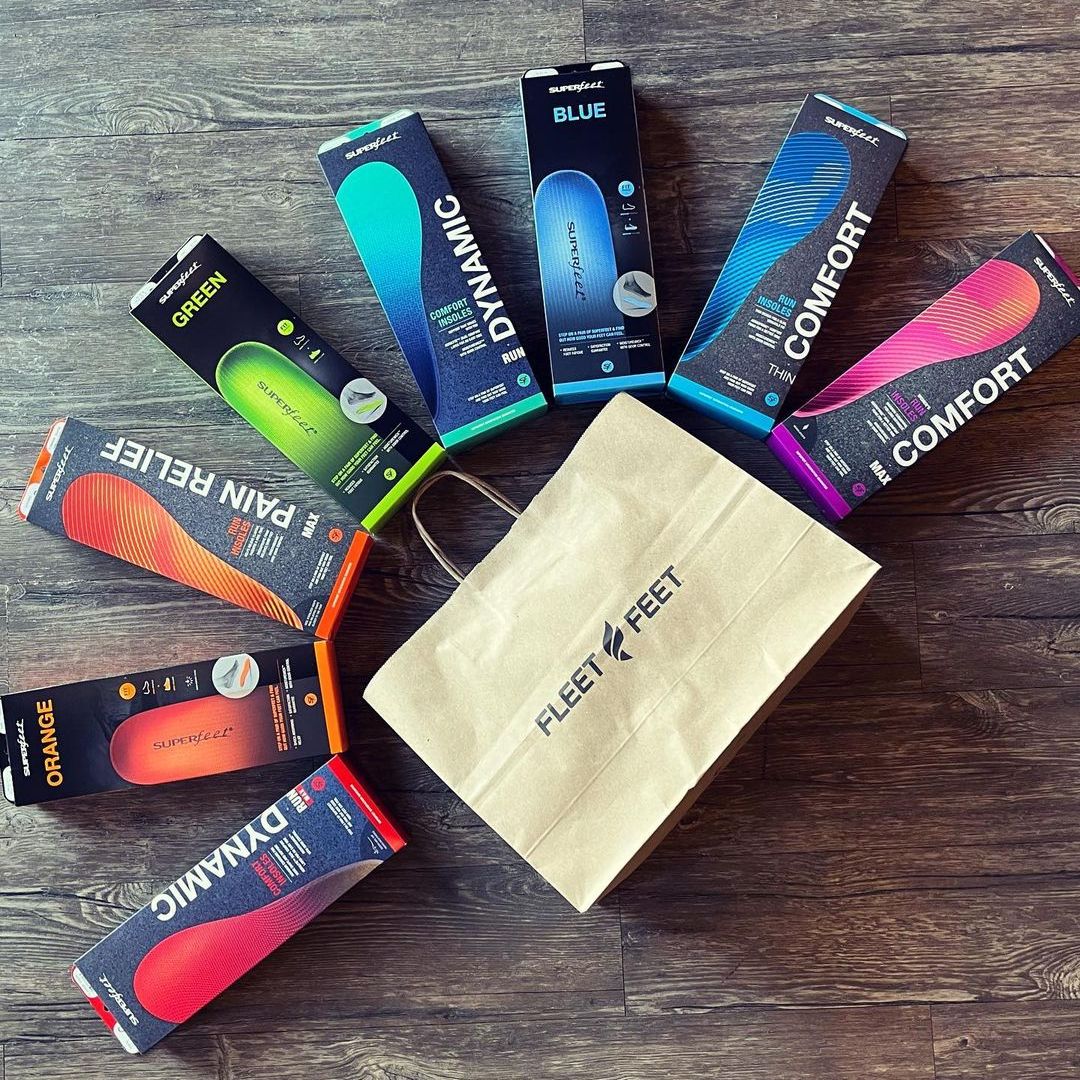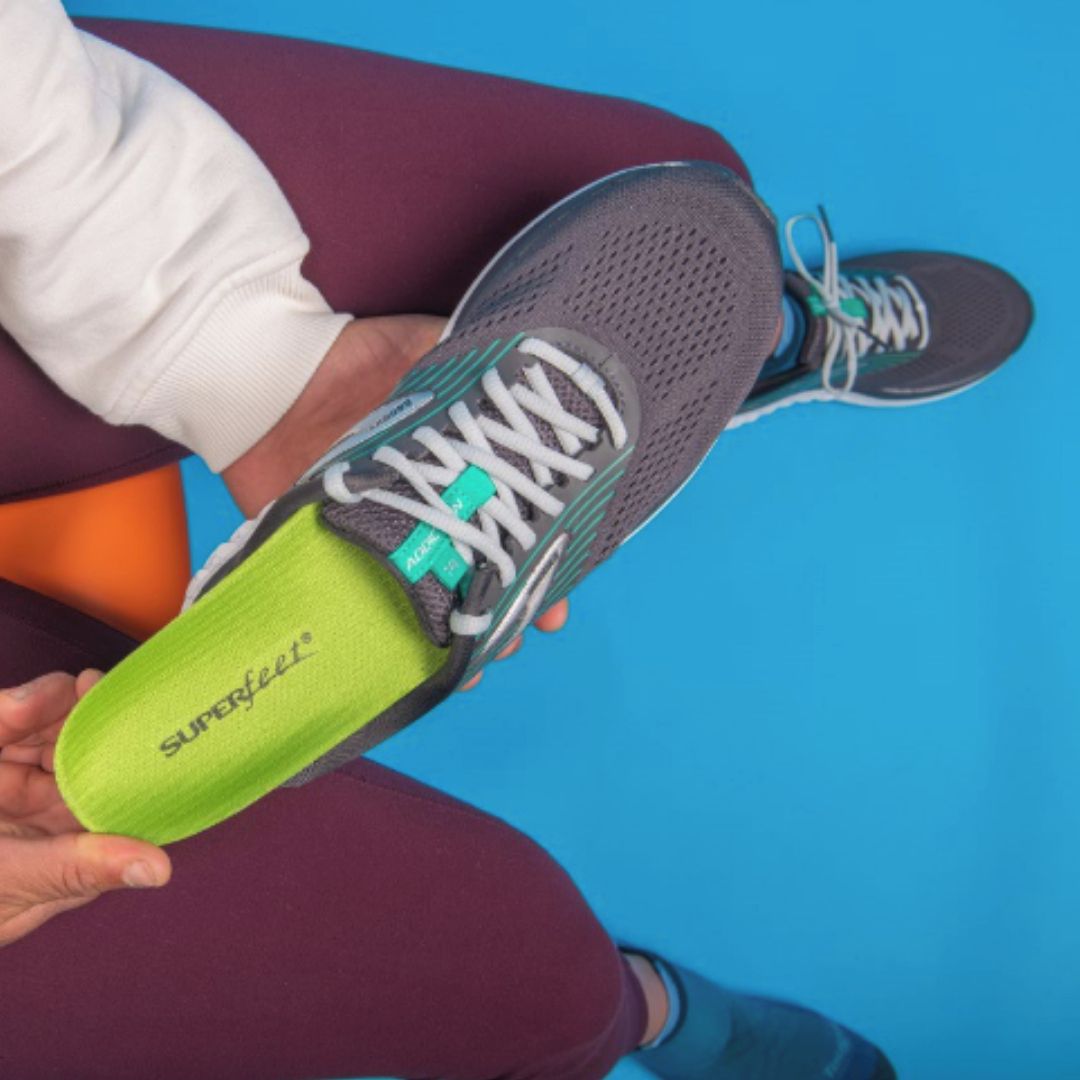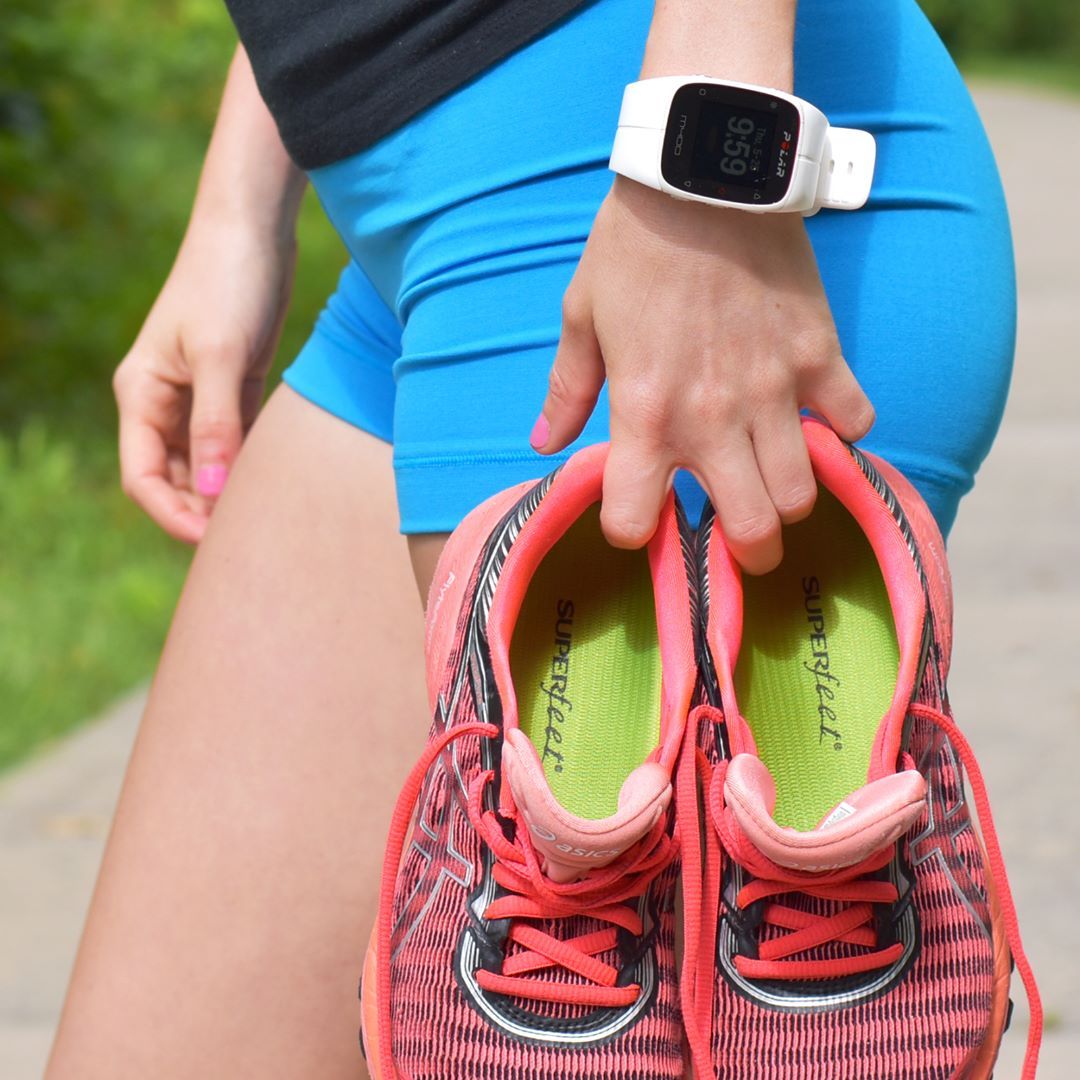5 Problems Our Insoles Can Solve
Whether you’re gearing up for a marathon or working on your feet all day, you want to keep your feet as comfortable as possible. From cushioned running shoes to moisture-wicking socks, your local Fleet Feet has everything you need to keep your feet happy. But what about insoles? Are they really necessary?

Superfeet insoles can add comfort and support to your footwear, helping your feet move efficiently. These insoles are inserted into your running shoes after you’ve removed the sock liner, the thin footbed that rests inside of the bottom of the shoe. The insoles help stabilize your foot within your shoe, reducing excessive movement which, in turn, delays fatigue and increases efficiency.
But who are Superfeet insoles best for and how do they work? Read on to learn about the 5 problems Superfeet insoles can solve.

1. Foot, shin and ankle pain
Ah, the runner’s trifecta. Nothing quite takes a pounding like your feet, ankles and shins do as you’re racking up the miles, which can lead to common overuse injuries. But a pair of insoles, (combined with the proper strength and mobility routine, of course) can help guide your feet forward and reduce excessive side-to-side movement.
Imagine your feet are bowling balls hurtling down a lane. Superfeet insoles have a deep heel cup that holds your foot in place, acting like guide rails to help keep your feet, the bowling balls, moving straight down the lane.
2. Heel slippage inside of your shoe
Most of us have, at one time or another, found what appeared to be the perfect-fitting shoe. The cushion was comfortable and the fit was perfect, until you took a few steps and realized your heels were slipping out the backs of your once-perfect shoes.
While running shoes use a vast array of technologies and materials, the insides of the shoes, like the sock liners, are all similar. This is done purposefully so the shoes can fit a wide variety of feet. But it means that, even if you’re wearing the right size, your feet may have too much room within the shoe. Adding an insole into your running shoe will help fill some of that extra room, improving the fit and reducing issues like heel slippage.
3. Heel pain
Our bodies are incredibly resilient and come with many handy mechanisms to help us survive. While we may not be hunter-gatherers anymore, we’ve retained these traits, including the soft, fatty pad underneath our heels. But our heels take a pounding when we run, and heel pain is a common ailment among avid runners and walkers.
The deep heel cup of a Superfeet insole can help reposition that soft tissue directly underneath the spot that receives the most impact, creating an extra barrier of cushioning beneath you and the ground.
4. Big toe pain
Maybe you wouldn’t think that a single toe could play such an important role in your running form, but the big toe is what most runners use to push off during the last phase of the gait cycle. Unfortunately, this can happen too rapidly or with too much pressure, causing pain.
Wearing the proper shaped insoles for your feet helps guide your foot forward more efficiently, slowing down that transition and reducing unnecessary pressure on your toe, thus eliminating pain.
5. Arch pain
Arch pain is often the result of one of two scenarios. In the first scenario, your arch is being overworked and straining from the load of running, walking or other strenuous activities. In the second scenario, your arch isn’t being allowed to do its job properly, whether that’s from ill-fitting footwear or problems in your gait.
The first step in addressing arch pain is figuring out your arch profile, which Fleet Feet Outfitters can do using our 3D fit id foot scanning technology. Runners with low arch profiles tend to need extra support underfoot because their arches flatten out and roll in as they land. Runners with high arch profiles can benefit from an insole that fills the gap between their arch and the bottom of the shoe, allowing the muscle to work more efficiently.
Most running shoes are flat on the inside and don’t come with built-in arch support. This allows them to fit a wide variety of arch profiles and foot shapes, but it also means that adding some extra support in the form of an insole may be necessary.
1. Foot, shin and ankle pain
Ah, the runner’s trifecta. Nothing quite takes a pounding like your feet, ankles and shins do as you’re racking up the miles, which can lead to common overuse injuries. But a pair of insoles, (combined with the proper strength and mobility routine, of course) can help guide your feet forward and reduce excessive side-to-side movement.
Imagine your feet are bowling balls hurtling down a lane. Superfeet insoles have a deep heel cup that holds your foot in place, acting like guide rails to help keep your feet, the bowling balls, moving straight down the lane.
2. Heel slippage inside of your shoe
Most of us have, at one time or another, found what appeared to be the perfect-fitting shoe. The cushion was comfortable and the fit was perfect, until you took a few steps and realized your heels were slipping out the backs of your once-perfect shoes.
While running shoes use a vast array of technologies and materials, the insides of the shoes, like the sock liners, are all similar. This is done purposefully so the shoes can fit a wide variety of feet. But it means that, even if you’re wearing the right size, your feet may have too much room within the shoe. Adding an insole into your running shoe will help fill some of that extra room, improving the fit and reducing issues like heel slippage.
3. Heel pain
Our bodies are incredibly resilient and come with many handy mechanisms to help us survive. While we may not be hunter-gatherers anymore, we’ve retained these traits, including the soft, fatty pad underneath our heels. But our heels take a pounding when we run, and heel pain is a common ailment among avid runners and walkers.
The deep heel cup of a Superfeet insole can help reposition that soft tissue directly underneath the spot that receives the most impact, creating an extra barrier of cushioning beneath you and the ground.
4. Big toe pain
Maybe you wouldn’t think that a single toe could play such an important role in your running form, but the big toe is what most runners use to push off during the last phase of the gait cycle. Unfortunately, this can happen too rapidly or with too much pressure, causing pain.
Wearing the proper shaped insoles for your feet helps guide your foot forward more efficiently, slowing down that transition and reducing unnecessary pressure on your toe, thus eliminating pain.
5. Arch pain
Arch pain is often the result of one of two scenarios. In the first scenario, your arch is being overworked and straining from the load of running, walking or other strenuous activities. In the second scenario, your arch isn’t being allowed to do its job properly, whether that’s from ill-fitting footwear or problems in your gait.
The first step in addressing arch pain is figuring out your arch profile, which Fleet Feet Outfitters can do using our 3D fit id foot scanning technology. Runners with low arch profiles tend to need extra support underfoot because their arches flatten out and roll in as they land. Runners with high arch profiles can benefit from an insole that fills the gap between their arch and the bottom of the shoe, allowing the muscle to work more efficiently.
Most running shoes are flat on the inside and don’t come with built-in arch support. This allows them to fit a wide variety of arch profiles and foot shapes, but it also means that adding some extra support in the form of an insole may be necessary.
1. Foot, shin and ankle pain
Ah, the runner’s trifecta. Nothing quite takes a pounding like your feet, ankles and shins do as you’re racking up the miles, which can lead to common overuse injuries. But a pair of insoles, (combined with the proper strength and mobility routine, of course) can help guide your feet forward and reduce excessive side-to-side movement.
Imagine your feet are bowling balls hurtling down a lane. Superfeet insoles have a deep heel cup that holds your foot in place, acting like guide rails to help keep your feet, the bowling balls, moving straight down the lane.
2. Heel slippage inside of your shoe
Most of us have, at one time or another, found what appeared to be the perfect-fitting shoe. The cushion was comfortable and the fit was perfect, until you took a few steps and realized your heels were slipping out the backs of your once-perfect shoes.
While running shoes use a vast array of technologies and materials, the insides of the shoes, like the sock liners, are all similar. This is done purposefully so the shoes can fit a wide variety of feet. But it means that, even if you’re wearing the right size, your feet may have too much room within the shoe. Adding an insole into your running shoe will help fill some of that extra room, improving the fit and reducing issues like heel slippage.
3. Heel pain
Our bodies are incredibly resilient and come with many handy mechanisms to help us survive. While we may not be hunter-gatherers anymore, we’ve retained these traits, including the soft, fatty pad underneath our heels. But our heels take a pounding when we run, and heel pain is a common ailment among avid runners and walkers.
The deep heel cup of a Superfeet insole can help reposition that soft tissue directly underneath the spot that receives the most impact, creating an extra barrier of cushioning beneath you and the ground.
4. Big toe pain
Maybe you wouldn’t think that a single toe could play such an important role in your running form, but the big toe is what most runners use to push off during the last phase of the gait cycle. Unfortunately, this can happen too rapidly or with too much pressure, causing pain.
Wearing the proper shaped insoles for your feet helps guide your foot forward more efficiently, slowing down that transition and reducing unnecessary pressure on your toe, thus eliminating pain.
5. Arch pain
Arch pain is often the result of one of two scenarios. In the first scenario, your arch is being overworked and straining from the load of running, walking or other strenuous activities. In the second scenario, your arch isn’t being allowed to do its job properly, whether that’s from ill-fitting footwear or problems in your gait.
The first step in addressing arch pain is figuring out your arch profile, which Fleet Feet Outfitters can do using our 3D fit id foot scanning technology. Runners with low arch profiles tend to need extra support underfoot because their arches flatten out and roll in as they land. Runners with high arch profiles can benefit from an insole that fills the gap between their arch and the bottom of the shoe, allowing the muscle to work more efficiently.
Most running shoes are flat on the inside and don’t come with built-in arch support. This allows them to fit a wide variety of arch profiles and foot shapes, but it also means that adding some extra support in the form of an insole may be necessary.

Remember, there are many Superfeet styles available, and choosing the right one will depend on the shape of your feet, your arch profile and, just like with running shoes, the type of underfoot feeling you prefer. You can learn about the shape of your feet and arches by getting fit by an expert at your local Fleet Feet.
Connect With Us
see the latest from Fleet Feet Tulsa